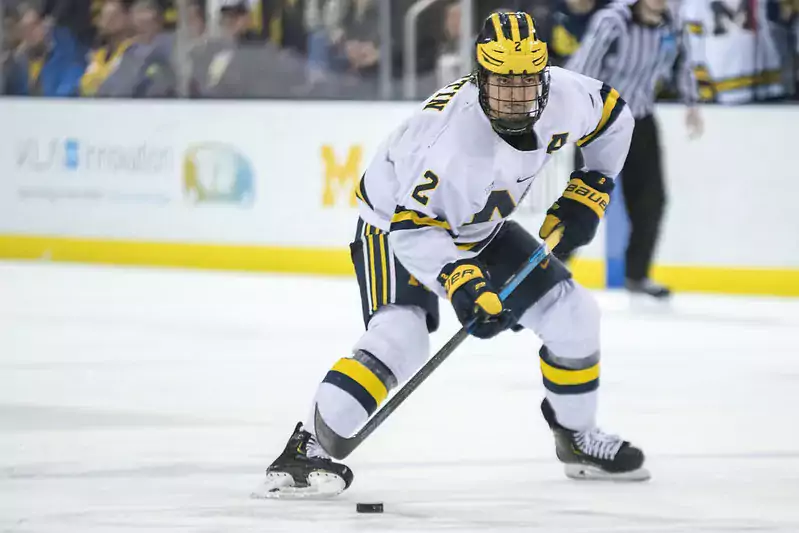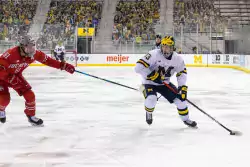Hockey nuts and bolts

Learning Hockey, a Summer Series: Previously College Hockey 101, Nuts and Bolts 1: Transition Play, Nuts and Bolts 2: Forechecking, Nuts and Bolts 3: Power Plays
Part 4 of our Nuts and Bolts series will look at the penalty kill. Monday's piece took a look at power plays, and so today we handle the opposite. If you haven't read part 3, I'd recommend doing so, because this deep dive on PK's goes hand-in-hand with that one on the PP, and I will make references to that piece here. Penalty killing is an extremely important component of the hockey game, even if it is only a small sliver of the total time on ice. Teams with poor penalty kills can see all their hard work at 5v5 erased in the matter of seconds if they cede a PPG or two to the opposition. Michigan Hockey fans may remember the 2017-18 Michigan team, whose bid for a national title was dashed because the team consistently couldn't kill penalties effectively in big moments. Penalty killing is every bit as important as the power play, and good teams should also be at least competent on the PK to seriously threaten for a championship in their respective league.
Penalty Killing
Killing penalties is the flip side to power plays and it often involves a different set of players. Though some elite forwards and defensemen can play on both the PP and PK (Owen Power, Nick Blankeburg, Matty Beniers, and Thomas Bordeleau all play on both for Michigan), you often switch out some of those high skill passers and shooters for players with more refined skill sets, ones who can block shots, win faceoffs reliably, and battle in the corner for loose pucks. Relentless forechecking ability, size, and smarts are valued on penalty kills, and those forwards and defensemen not known for offense who play down in their team's lineup often appear on penalty kills, which in Michigan's case tends to be guys like Nolan Moyle and Garrett Van Wyhe.
Penalty killing is less schematic than some of our previous topics (forechecking, PP's), and so instead I'm going to just go through several components of the penalty kill and identify traits that come in handy and that coaches value when building their penalty kills, although there will be some strategic discussion.
[AFTER THE JUMP: Let's Kill Some Penalties!]

Learning Hockey, a Summer Series: Previously College Hockey 101, Nuts and Bolts 1: Transition Play, Nuts and Bolts 2: Forechecking
Today's article will examine the power play, which in hockey is one component of special teams. Though the majority of the game is played at 5-on-5, leading many stat heads to place an emphasis on 5v5 metrics, special teams are still crucial. They comprise only around 20-25% of a given game, yet the nature of the situation (one team having more players than the other), makes it a huge tipping point in nearly every game. We just witnessed the Tampa Bay Lightning, who will get plenty of discussion in this piece, win two playoff rounds largely because their elite power play was too much for the opposition to handle, which should provide evidence for the importance of special teams. A bad power play is a major weakness that the opposition can expose, and a good team should be at least average on the PP.
Power Plays
This piece will mostly discuss PP's in their 5v4 variety, as opposed to rarer kinds like 5v3, 6v4, or 4v3. It's important to first remember that a very good power play, be it at the NCAA or NHL level, is only going to convert at roughly a 25% clip. Last year's Michigan team had the 7th best PP in college hockey, firing at 23.7%. That's pretty standard for an elite power play. So we shouldn't pretend like scoring on a PP is easy or that you can do it all the time. However, what should be expected is that a good PP gets at least 1-2 quality looks each PP opportunity. If the shots go wide, or the goalie comes up with a huge save, so be it. But generating those chances is the objective of the PP.
[AFTER THE JUMP: You like diagrams? I like diagrams!]

Learning Hockey, a Summer Series: Previously College Hockey 101, Nuts and Bolts 1: Transition Play
Last time we took a look a transition play, zone exits, regroups/counters, and then zone entries. Today we're going to examine a different part of the game, what happens when you're in the neutral/offensive zones and you don't have the puck, also known as a forecheck. Forechecks are integral to a team's system and are drilled down in practice by coaches. They are some of the most structured parts of how a hockey team plays and thus can be the easiest to analyze in this sort of format.
In the simplest terms, forechecks are what teams use to get the puck back in the neutral or offensive zone. Their goal is to obstruct the opposition moving up the ice (in the OZ, a forecheck aims to stop a zone exit; in the NZ, a forecheck aims to stop a zone entry) and then force a turnover. A team's forecheck is part of the bread and butter of that team's system and can define the way they play and the kinds of games they get involved in. Forechecks differ in where on the ice they're applied and also in how they're applied, specifically as to what amount of pressure they put on the opponent. We will go through both dimensions and talk about common examples.
Offensive Zone Forechecks
This is applied in the offensive zone in a few situations. For example, after the puck is dumped in, a team will shift into an offensive zone forecheck as it goes to retrieve the puck. Similarly, after a shot is taken and saved, and the defending team now gets it and attempts its zone exit, the other team will go into an offensive zone forecheck to keep the puck in the zone and recover it to extend the offensive possession. When we speak about certain players being "good forecheckers", this is generally what we refer to, their ability to help recover the puck in the offensive zone while playing inside a broader offensive zone forecheck scheme.
An offensive zone forecheck is generally pretty aggressive, with the intent of pressuring the opponent to turn it over, so that either an offensive possession can begin or can be extended. An OZ forecheck has many different forms, and the alignments may be identical in name to some neutral zone forechecks we'll talk about, but what they actually do and how they operate will be quite different. I will walk through some of them and show clips of how they work.
[AFTER THE JUMP: Lots of diagrams and coach-speak]

The first part of a series on hockey strategy, looking at offensive transition play.
2